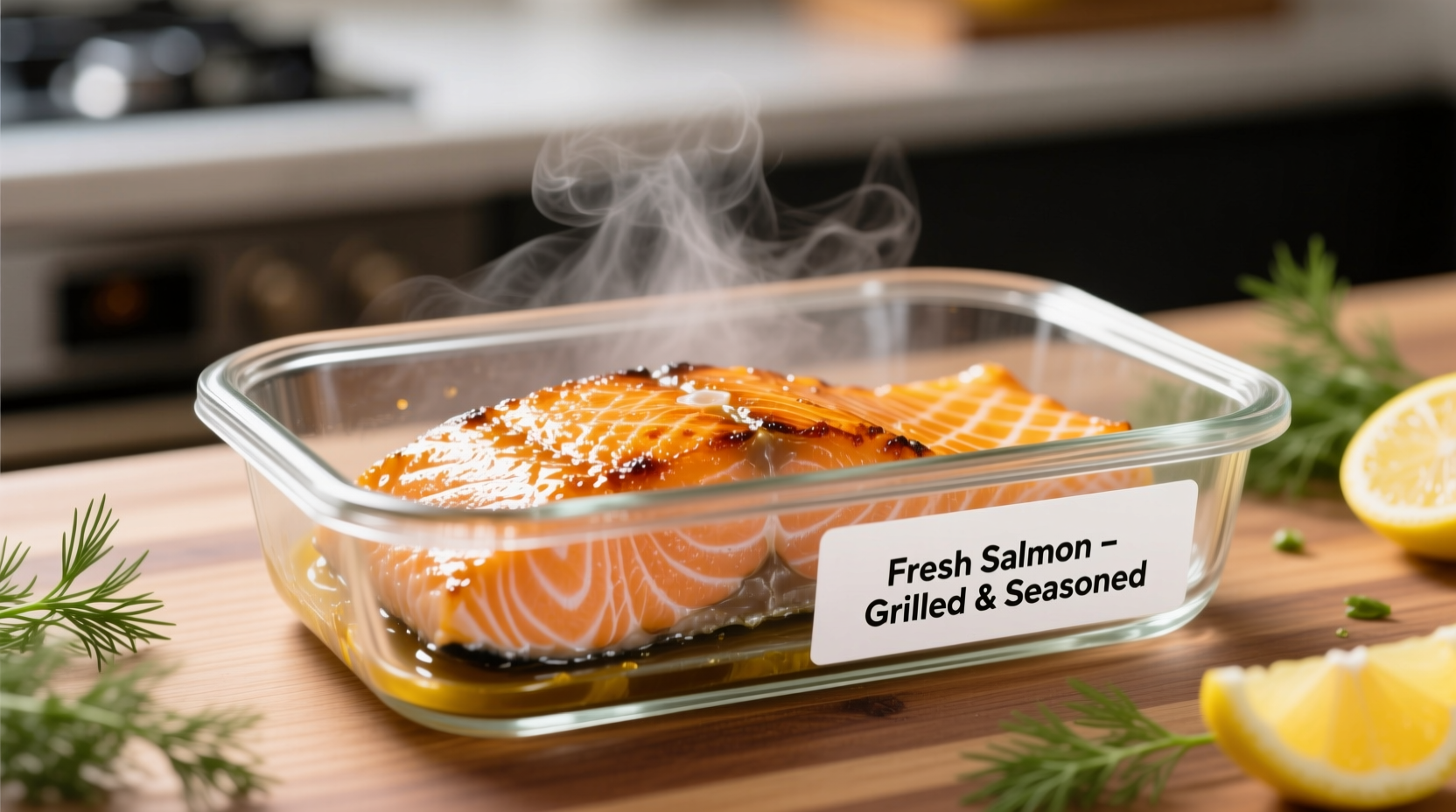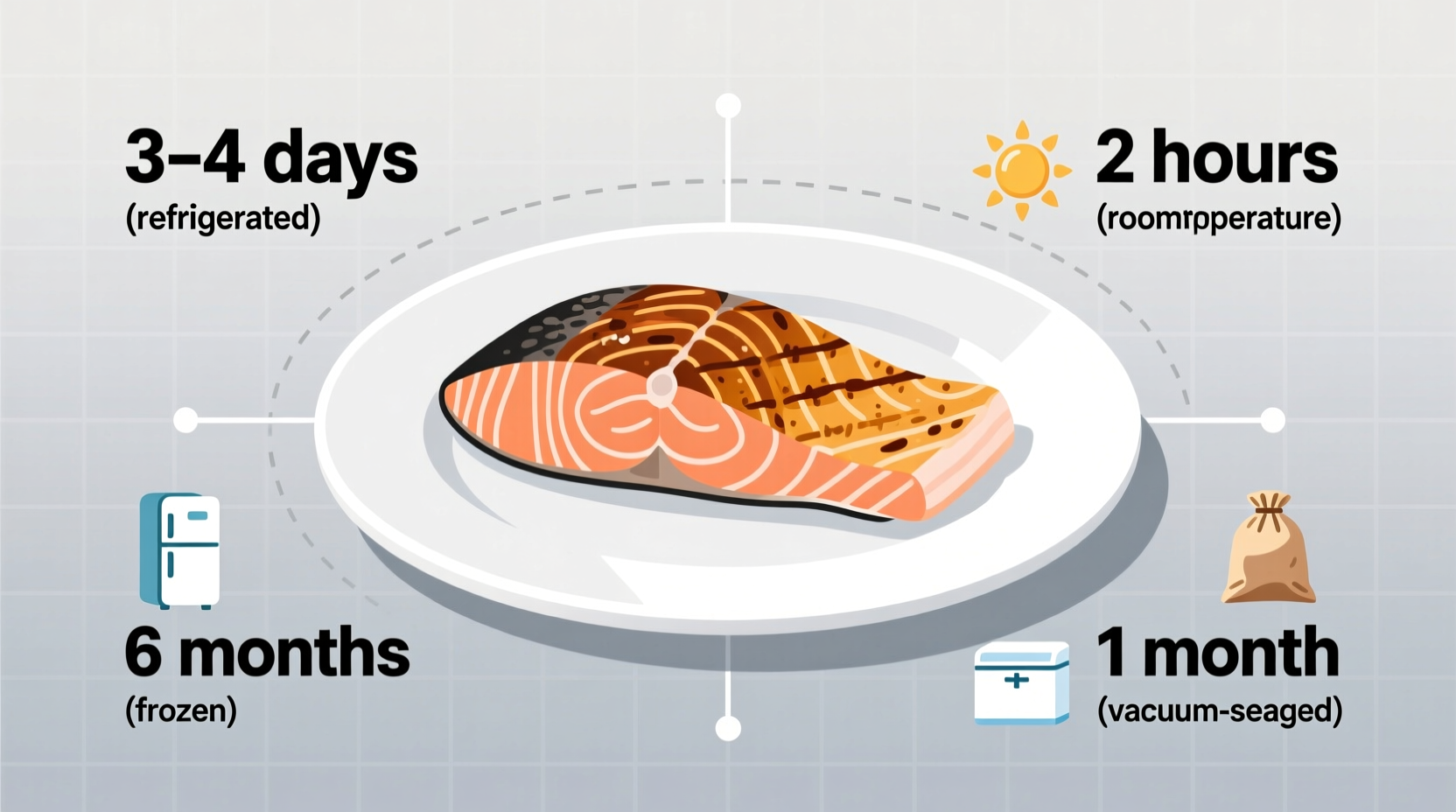Cooked salmon stays safe to eat for 3-4 days when properly stored in the refrigerator at 40°F (4°C) or below. In the freezer, it maintains best quality for 2-3 months. Never leave cooked salmon at room temperature for more than 2 hours (1 hour if ambient temperature exceeds 90°F/32°C).
Wondering if that leftover salmon from last night's dinner is still safe to eat today? You're not alone. Millions of home cooks face this food safety dilemma weekly. Getting storage times wrong could lead to foodborne illness, while throwing away perfectly good food contributes to the staggering 30-40% of food waste in American households. This guide delivers precise, science-backed information so you can confidently enjoy your leftovers while staying safe.
Understanding Cooked Salmon Storage Timelines
Knowing exactly how long cooked salmon remains safe isn't just convenient—it's essential for preventing foodborne illness. The USDA Food Safety and Inspection Service provides clear guidelines based on extensive food safety research. Let's break down exactly what happens to cooked salmon during storage.
| Storage Method | Temperature | Safe Duration | Quality Considerations |
|---|---|---|---|
| Refrigerator | 40°F (4°C) or below | 3-4 days | Best quality within first 2 days; texture degrades after day 3 |
| Freezer | 0°F (-18°C) | 2-3 months | Optimal flavor and texture within first 2 months; safe indefinitely but quality declines |
| Room Temperature | Above 40°F (4°C) | 2 hours max (1 hour if >90°F/32°C) | Bacteria multiply rapidly in the "danger zone" (40°F-140°F) |
Why Proper Storage Matters for Cooked Salmon
Cooked salmon enters what food safety experts call the "danger zone" when temperatures rise between 40°F and 140°F (4°C-60°C). Within this range, bacteria like Listeria and Staphylococcus aureus multiply rapidly. The FDA Food Code specifically identifies cooked seafood as a potentially hazardous food requiring strict temperature control. Unlike raw fish, cooked salmon has had its natural protective barriers broken down during cooking, making it more vulnerable to bacterial growth.
Step-by-Step Guide to Storing Cooked Salmon Properly
Following these professional kitchen techniques will maximize both safety and quality:
- Cool rapidly – Divide large portions into smaller containers to cool faster. Never place a large, hot container directly in the refrigerator.
- Use proper containers – Transfer salmon to airtight containers or wrap tightly in heavy-duty aluminum foil or plastic wrap. Glass containers with locking lids work best for refrigerator storage.
- Label everything – Note the date of cooking on the container. "When in doubt, throw it out" applies particularly to seafood.
- Store in the coldest part – Place containers on the bottom shelf of your refrigerator, not in the door where temperatures fluctuate.
- Freeze correctly – For freezing, wrap portions in freezer paper, then place in airtight freezer bags, removing as much air as possible to prevent freezer burn.

How to Tell If Cooked Salmon Has Gone Bad
Don't rely solely on the calendar—your senses provide crucial safety information. According to research from the University of California's Food Safety Program, these are the definitive signs that cooked salmon should be discarded:
- Smell test – Fresh cooked salmon has a mild, ocean-like aroma. A sour, ammonia-like, or overly fishy smell indicates spoilage.
- Texture changes – Slimy or sticky surface texture (not to be confused with natural oiliness) means bacteria have begun breaking down the proteins.
- Visual cues – Discoloration (grayish tinge, milky residue), mold growth, or significant darkening are clear warning signs.
- Taste test (not recommended) – If you've reached the point of tasting questionable salmon, it's already too late—discard it immediately.
Common Mistakes That Shorten Cooked Salmon's Shelf Life
Even with proper storage timelines, these common errors can make your salmon unsafe before the 3-4 day mark:
- Leaving cooked salmon on the counter to cool completely (should move to refrigerator within 2 hours)
- Storing in shallow containers that don't seal properly
- Placing warm salmon directly in the refrigerator (raises internal temperature)
- Using containers that previously held strong-smelling foods
- Reheating and then re-refrigerating multiple times
Maximizing Flavor and Texture in Leftover Salmon
While safety is paramount, you also want your leftovers to taste great. Professional chefs recommend these techniques for optimal reheating:
- Reheat gently at low temperatures to prevent drying out
- Add moisture with a splash of broth, lemon juice, or olive oil
- Use oven or stovetop methods rather than microwave for best results
- Flake reheated salmon into salads or pasta dishes rather than serving whole
- Consider transforming leftovers into salmon cakes or patties
Special Considerations for Different Salmon Preparations
Not all cooked salmon is created equal when it comes to storage. The FDA notes that preparation methods affect shelf life:
- Plain grilled or baked salmon – Follow standard 3-4 day refrigeration guidelines
- Salmon in sauce or with dairy – Reduce storage time to 2-3 days as dairy components spoil faster
- Smoked salmon – Commercially smoked lasts 1-2 weeks refrigerated; homemade smoked salmon should be consumed within 5 days
- Salmon dishes with vegetables – Storage time determined by the most perishable ingredient
When in Doubt, Throw It Out
Food safety experts consistently emphasize that when you're uncertain about the safety of cooked salmon, the only correct choice is to discard it. According to the USDA's FoodKeeper app data, approximately 40% of foodborne illness cases originate from improper handling of leftovers. Your health is worth far more than the cost of a few ounces of fish. Remember that food poisoning symptoms can take hours to days to appear, making it difficult to connect illness with specific foods.
Frequently Asked Questions
Can I eat cooked salmon after 5 days in the refrigerator?
No, cooked salmon should not be consumed after 5 days in the refrigerator. The USDA Food Safety and Inspection Service recommends discarding cooked fish after 3-4 days of refrigeration, even if it appears and smells normal. Bacteria that cause foodborne illness often don't produce noticeable changes in food.
How can I tell if frozen cooked salmon has gone bad?
Frozen cooked salmon doesn't technically "go bad" in terms of safety if kept at 0°F (-18°C) or below, but quality deteriorates over time. Signs of freezer burn include white, dry patches on the surface, a tough texture, and off flavors. For best quality, consume frozen cooked salmon within 2-3 months.
What's the safest way to thaw frozen cooked salmon?
The safest thawing methods are: 1) In the refrigerator (allow 24 hours for complete thawing), 2) Under cold running water (change water every 30 minutes), or 3) In the microwave using the defrost setting (cook immediately after thawing). Never thaw cooked salmon at room temperature, as this allows bacteria to multiply rapidly in the outer layers while the center remains frozen.
Can I refreeze cooked salmon after thawing?
Yes, but only if it was thawed in the refrigerator and hasn't been left out at room temperature. Refreezing may affect texture and quality, but it remains safe. Do not refreeze cooked salmon that was thawed using cold water or microwave methods unless it was fully cooked after thawing. Each thaw-freeze cycle degrades quality, so for best results, divide into single-serving portions before initial freezing.
Does reheating cooked salmon kill bacteria that may have grown during storage?
No, reheating does not eliminate all risks. While proper reheating (to 165°F/74°C) kills active bacteria, it doesn't destroy heat-stable toxins produced by some bacteria during growth. If salmon has been stored beyond recommended times, reheating won't make it safe to eat. Always follow storage timelines rather than relying on reheating for safety.











 浙公网安备
33010002000092号
浙公网安备
33010002000092号 浙B2-20120091-4
浙B2-20120091-4